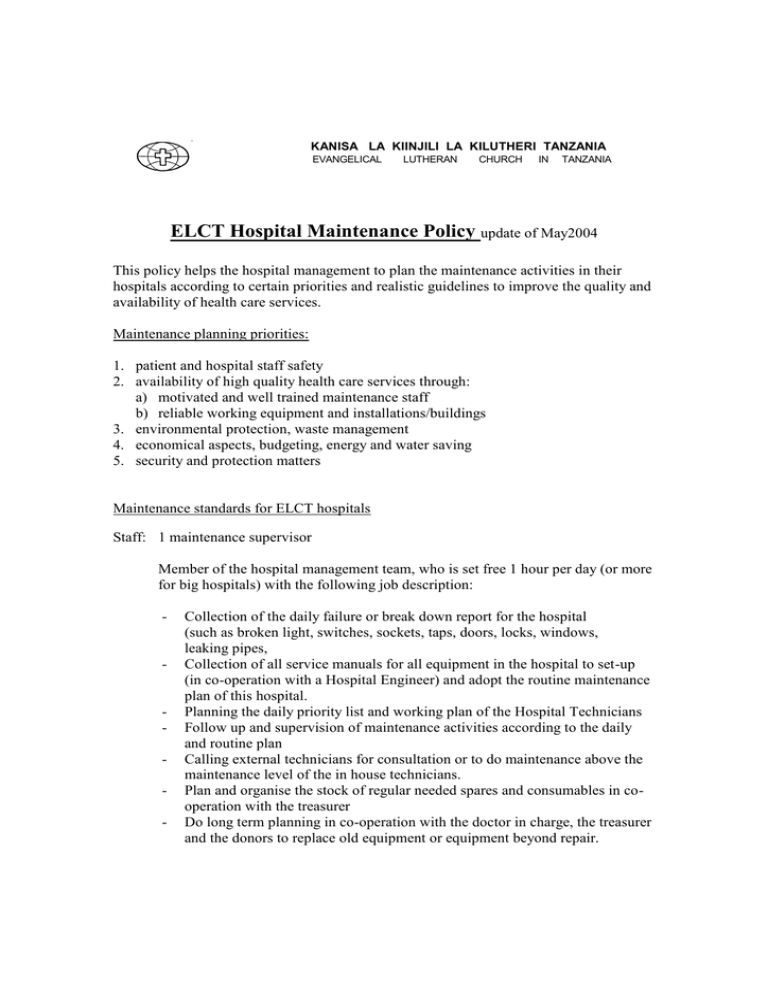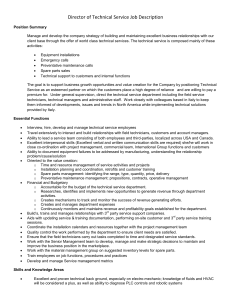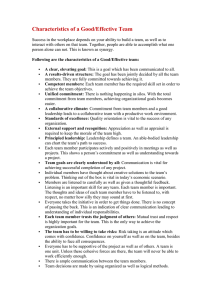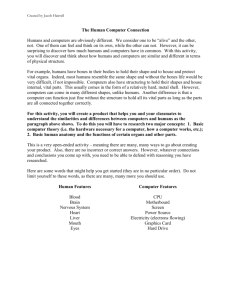ELCT Hospital Maintenance Policy update of May2004
advertisement

KANISA LA KIINJILI LA KILUTHERI TANZANIA EVANGELICAL LUTHERAN CHURCH IN TANZANIA ELCT Hospital Maintenance Policy update of May2004 This policy helps the hospital management to plan the maintenance activities in their hospitals according to certain priorities and realistic guidelines to improve the quality and availability of health care services. Maintenance planning priorities: 1. patient and hospital staff safety 2. availability of high quality health care services through: a) motivated and well trained maintenance staff b) reliable working equipment and installations/buildings 3. environmental protection, waste management 4. economical aspects, budgeting, energy and water saving 5. security and protection matters Maintenance standards for ELCT hospitals Staff: 1 maintenance supervisor Member of the hospital management team, who is set free 1 hour per day (or more for big hospitals) with the following job description: - - - Collection of the daily failure or break down report for the hospital (such as broken light, switches, sockets, taps, doors, locks, windows, leaking pipes, Collection of all service manuals for all equipment in the hospital to set-up (in co-operation with a Hospital Engineer) and adopt the routine maintenance plan of this hospital. Planning the daily priority list and working plan of the Hospital Technicians Follow up and supervision of maintenance activities according to the daily and routine plan Calling external technicians for consultation or to do maintenance above the maintenance level of the in house technicians. Plan and organise the stock of regular needed spares and consumables in cooperation with the treasurer Do long term planning in co-operation with the doctor in charge, the treasurer and the donors to replace old equipment or equipment beyond repair. - Choosing of appropriate new equipment according to the standard equipment list in co-operation with a hospital engineer - Looking for ways of energy and water saving in co-operation with a hospital engineer - Supervision of proper waste disposal - Organise the maintenance check for the hospital every second year (see assessment of present maintenance situation) per 80 hospital beds: 1 full employed multi-purpose technician with trade test No. 1 or 2, better FTC in electricity and successful passed Hospital Technician Course in Mvumi. 1 (part time) employed multi-purpose technician with trade test in plumbing or carpentry job description of in house technicians: - Doing routine maintenance according to their maintenance levels and the service manuals following the routine maintenance plan for this hospital Follow the daily plan of the maintenance supervisor Report all faulty equipment to the maintenance supervisor Update hospital inventory and routine maintenance plan Definition of the maintenance level of in house technicians: The technician should be able to service and the repair the following systems: Electricity installation (wiring, fuses sockets, lights), water installation (pipes, tanks, taps, toilets, waste water), building and furniture repair work, simple mechanical equipment (e.g. BP machine), simple electrical equipment (e.g. Pumps, sucker, kettle, iron, washing machine), oil and filter change on cars and diesel generators. Routine maintenance on cars, generators or sophisticated equipment according to the user manual (not service manual). The in house technician must never work beyond this level. The following equipment needs external qualified personal or additional qualification courses: Any electronic (medical, office) equipment (e.g. Ultrasound, Computer, Radio Call), X-ray equipment, Oxygen Concentrator, Diathermy, Anastasia equipment (EMO), refrigerators, advanced car-, generator- equipment maintenance following the service manuals. Equipment: (see also appendix standard equipment list) - Vital equipment must be in good working condition and proved safe at any time. There must be enough consumables on stock to use it for at least 1 month. For most vital equipment there is a back up equipment recommended. If vital equipment brakes, it has to be repaired with highest priority. Vital equipment should be replaced if there are no spare parts available any more from the manufacturer. Second hand vital equipment should not be older than 15 years and supplied with a full set of English user- and service manuals. - Essential equipment must be in working condition and proved safe. The break down time without replacement or back up equipment should not exceed 3 months. Equipment older than 25 years, which is faulty, should be replaced by second hand or new equipment. - Before equipment is shipped to Tanzania ELCT HCTS or another Medical Engineer has to be contacted to proof that the equipment is sent according to the ELCT standards and the equipment guidelines for donations. (see appendix) Workshop: Each Hospital must have a workshop. It must have a minimum size of 25m 2 and equipped with working benches and tool sets according to the ELCT standard equipment list. The Maintenance Supervisor is in charge of the workshop and makes sure that the technicians keep it clean and the inventory remains complete. Defective tools have to be replaced in time by the hospital. Store: Each Hospital must have a store for basic spare parts. Definition Basic spare parts: Spars and consumables, which are needed for the routine maintenance and minor repair work according to the maintenance level of the hospital technician. (e.g. consumables for vital equipment, bulbs, tube-lights, fuses, plugs, sockets, fittings for plumbing, taps, pipes, timber, screws, nails, paint, oil …) Waste Disposal: The hospital must have a fenced area to treat waste. It needs a special deep pit (4 meters or more) for infectious wet material, which has a lid to close it. There must be a second pit for all non-infectious wet material. These pits must be far from any spring or borehole. As the pit fills up, it has to be filled up and covered with soil completely. There has to be a simple incinerator to burn all dry burnable materials. The dry waste has to be burned immediately and completely when filled into the incinerator. This work has to be done by trained staff and checked regularly by the maintenance supervisor. Waste must be collected in different containers and treated differently as follows: 1. Sharps (needles, knives etc. ) To be dumped in a deep pit, which has a lid to close it. 2. Dry infectious material (infusion tubes, plastic bottles syringes, gloves etc. ) To be burned in an incinerator. 3. Dry material (paper, plastic, wood…) To be burned in an incinerator 4. Wet infectious material (from theatre or maternity..) To be dumped in a deep pit which has a lid to close it. 5. Wet material (from the kitchen or wards..) To be dumped in the pit or to produce compost. Budget: The hospital must have a budget for maintenance including the following expenses: Capital Budget: per annum per 100 beds (examples) Building (renovations) Equipment replacement 1 % of value new in cooperation with donors to be defined in detail in cooperation with donors e.g. 10 million Tshs Recurrent Budget Equipment Maintenance 5-6% of new value per year Technician salaries 1.5 million Tshs Basic spare parts stock 5 million Tshs External Services 3 million Tshs Equipment running costs (power, water, consumables..) Tools replacement to be defined in detail for each piece of equipment e.g. 15 million Tshs total 5% of value new e.g. 200.000,- Tshs Assessment of present maintenance situation: To assess the present maintenance situation in a hospital certain areas have to be checked in detail. (In the appendix you can find a detailed questionnaire to qualify the present maintenance situation in a hospital.) This assessment should also be a planning tool for priorities in planning and budgeting to spend resources as effective as possible. This kind of assessment should be done every second year in a hospital by an external qualified Hospital Engineer and include the following points: 1. validation and safety check of sterilisation (including a Bowie and Dick test of autoclaves) 2. safety check of all medical equipment (including function check, electrical and physical safety) 3. safety check of electrical installation 4. validation and check of buildings and compound (including water system, doors, furniture, roof, security, fencing, fire extinguisher, waste disposal) 5. validation of maintenance done by (hospital-) technicians 6. complete report with priority list for the maintenance plan (including needed repair work, replacement of equipment and hints for appropriate technology and standardisation, maintenance budget proposal) 7. updating of inventory of medical equipment ELCT Health Care Technical Service Policy HCTS is ready to serve any hospital or church institution in Tanzania following these rules to use its little recourses most effectively: 1. HCTS is acting on request only 2. Service Requests are only followed up under the following conditions: a) There is no other technician available or qualified to do the job, so that the task can not be delegated to somebody else (see also 5.) b) HCTS is qualified to do the job c) The last request has been paid d) The task(s) had been described in detail, so that a visit can be planned well and e.g. spares can be organised in advanced to avoid expensive extra trips. e) The hospital agrees to pay the actual HCTS charges (see 10.) 3. Service Requests from Charitable Hospitals have more priority than from other institutions. 4. Preventive Maintenance has more priority than repair and installation work 5. HCTS tries to reduce dependencies on its services by involving local technicians in the requested tasks and trains them for future service and repair work. 6. Running Costs have to be covered by the local income, to make the service more sustainable. 7. Income generating projects of HCTS have to be sustainable and functioning financially independent from HCTS. All projects have not the aim to make profit, however a surplus or cash income is used to finance advanced expenses of other HCTS services. 8. To be able to manage all office work, the travelling days should not exceed 10 Days per Month. 9. Consultancy and “remote fault finding” on the telephone or per (e-)mail is free of charge, because it helps to reduce travelling costs and time. 10. HCTS charges: a) 1000,- Tshs per hour in the workshop or 15000,- Tshs per travelling day b) 380,- Tshs per km c) Cost-coverage for spares d) Hospitals have to provide accommodation and food Appendix: ELCT Hospital Standard Equipment List The list includes so far the following departments of a Hospital: 1. Theatre 2. Central Sterilization and Supplies 3. Laboratory 4. Radiology 5. Maternity 6. Laundry 7. Power House 8. Workshop List of vital and essential equipment in these 8 departments: (this list includes equipment serviced by the HCTS team only, there are no standards yet for equipment less than 500 Euro in value) 1. Theatre: equipment name/ (number of pieces needed per 40 beds) Vital:= must be there Essential:= is important to have Operation table (1) Operation lamp (1) Operation light Anaesthetic eq. (1) Proposed standard type I Proposed standard type II Vital -hydraulic operated -movable on wheels -multy purpose position facilities according to the needs of hospital e.g: Stierien Marquart 117 VELOX II - Vital -battery backup 24V -standard halogen bulbs -4 to 5 bulbs -ceiling mounted -battery type lead acid (no sealed type) Essential -battery backup 12V -manual -1 to 3 bulbs (1) -battery type 12V lead acid e.g.: Dr. Mach Quintaflex R 96 - e.g.: Dr. Mach Polyflex - Vital Penlon EMO no other type Details Suction pump Vital ATMOS LC 36 Aerosol SAM 14 equipment name (number of pieces needed per 40 beds) Vital:= must be there Essential:= is important to have Proposed standard type I Proposed standard type II Suction Pump manual (2) Diathermy machine(1) Vital AMBU twin MEDAP P 0900 Essential ERBE T 175 E Alsa Alsatom MB Electric (2) Details 2. Sterilization : (water boilers/sterilizers should be abolished and be replaced with small autoclaves) equipment name (number of pieces needed per 40 beds) Vital:= must be there Essential:= is important to have Autoclave small (2) Vital Autoclave big (1) Vital KSG 50/70 WEBECO Model H equipment name (number of pieces needed per 40 beds) Vital:= must be there Essential:= is important to have Proposed standard type I Proposed standard type II Microscope(1) Vital ZEISS Standard KF 2 Hund Medicus HF Photometer (1) Vital Corning 252 no other type Centrifuge electric(1) Vital Hettich Universal II Heraeus Labf. II Centrifuge Heamatokrotid Essential Hettich Haemakrotid Heraeus Haemofug. Centrifuge manual (one per 80 beds) Vital e.g.: Hettich EAB3S Refrigerator(1) Vital Electric: domestic comressor type Proposed standard type I Proposed standard type II Details Aesculap 340ST KSG 30/50-1 3. Laboratory Details Gas/Kerosine /Electric: Electrolux Incubator Microbiology Essential Memmert M100 Heraeus T50 Vital:= must be there Essential:= is important to have Proposed standard type I Proposed standard type II 5. Radiology equipment name Details X-Ray (one per 80 beds) Essential Siemens PRIME X Philips BRS Ultrasound(one per 80 beds) Essential Aloka SSD500 Kranzbuehler al.100 Proposed standard type I Proposed standard type II Essential Draeger Permox Devilbiss MC 44 G Vital:= must be there Essential:= is important to have Proposed standard type I Proposed standard type II 5. Materninty equipment name / Thatre Vital:= must be there Essential:= is important to have Details Oxygen Concentrator (one per 40 beds) 6. Loundry equipment name Details Washing machine (one per 40 beds) Essential Stahl WA250 Miele WS5522 Spin dryer(one per 80 beds) Essential Stahl Z30 no other type NO ironing machine but: local available irons (2 per 40 peds) 7. Power House equipment name Vital:= must be there Essential:= is important to have Proposed standard type I proposed standard type II Iveco 2040kVA Caterpiller 20-40kVA Details Generator (only one if there is Tanesco) Uninterrupted Power supply (one per theatre) Vital For theatre, sterilization, lab and refrigerators only Essential -only professional lead acid batteries -min. 2kW for OP, Lab ect. 7. Workshop The workshop of the hospital technician has to be equipped with the following tool sets: Tool Tool Tool Tool Set Set Set Set Plumbing Carpenter Electric Car vital vital vital essential Equipment Donation Guidelines Adopted for ELCT from http://www.drugdonations.org/eng/richtlijnen/eng_guidelinesequipmentdon.pdf. Guidelines on MedicalEquipment Donation A Publication of The Pharmaceutical Programme – World Council of Churches (WCC) & Community Initiatives Support Services (CISS) A guide for those accepting and making donations. It is also useful for those planning to buy equipment Why do both recipients and donors need guidelines on the donation of equipment? Although donations of equipment and materials may improve the efficiency of health facilities, experience has shown that equipment donation may cause the recipient more problems than benefits. Reciepient should therefore develop clear policies on their equipment requirements. These should be shown to donors, who should respect them. Before a donation agreement is settled, donors and recipients should make a thorough evaluation of the requirements of both parties. The final choice of equipment will be limited by cost, environmental and operational conditions, the availability of supplies of spare parts and the quality of maintenance services. SUMMARY Recipient: 1. Standardise equipment This ensures a greater likelihood of : Economical purchasing of spare parts and appropriate storage Availability of instruction manuals Availability of local expertise in operation and maintenance procedures Selection of appropriate equipment 2. Involve technical departments Technicians can be asked to consider and advise upon: Installation, operation and maintenance requirements Staff and training requirements for users and technicians The essential spare parts required Appropriateness of equipment in terms of running costs and technical design 3. Specify clearly items to accompany the equipment These should include: A full set of technical documents in a specified language An agreed quantity of spare parts and supplies A document of warranty (guarantee) for the replacement or repair of faulty equipment 4. Make a check-list (see over) including all the above. This ensures that the donor receives enough information to make an appropriate response. 5. Communicate alternative preferences For example, if a financial contribution would be more appropriate than a donation of equipment from abroad, make this clear to the donor. Donor: 1. Communicate with the recipient Make sure that the potential recipient has provided a comprehensive description of the equipment required. 2. Supply fully functional equipment Test the equipment and make sure all necessary spare parts and supplies are included in the package before making shipment. Do not supply worn-out, broken or redundant equipment. 3. Supply all technical documents Installation, operation, maintenance and repair manuals and diagrams should be made available in a language understood by the users and the technicians. 4. Supply enough consumables and spare parts to last at least two years. Include a complete list of spare parts and indicate the name and address of the authorised dealer. 5. Ensure proper packaging and shipping: Use strong sturdy and easy-to-handle packing materials Include a comprehensive packing list. Supply shipping documents promptly 6. Offer technical assistance. This should include promoting, recommending and providing training for users and for maintenance personnel. 7. Understand the import regulations in the recipient’s country. Make sure that the recipient is able to cover the costs of custom duties and any other charges associated with importation. Guidelines on Medical Equipment Donations are made as a result of: A genuine desire to help response to a request by recipient A desire to utilize functional equipment not necessarily required by donor A need for financial gain However problems arise when: Donors of medical equipment may have no background in health issues, or an understanding of the structure of health services of the recipient (usually based in a developing country), and do not recognise the need to seek expert advice. New but inappropriate equipment is donated as a means of promoting and marketing it. Companies, hospitals or private doctors donate outmoded, outdated equipment as it provides them with tax exemptions or as a means of getting rid of redundant equipment. Potential donors with patronizing attitudes towards recipients, regard them as beggars desperate for any equipment and therefore don't consider it worthwhile to consult them. The recipient may compound this problem by feeling obliged to accept any donation, even though the equipment is unnecessary, or where charges such as import taxes and transport costs, are prohibitive. What can be done? The donor and the recipient must get together as equal partners to work out how the effort and goodwill involved in making a donation can be put to best use. The recipient's policy on equipment requirements should be known to the staff and the donors. The right to give and receive a “No, thank you” should be expressed, appreciated and accepted. A refusal (or acceptance) that is justified by a comprehensive statement of requirement is often much appreciated by the donor. To help build a comprehensive statement of requirement, the following list of criteria may be useful. Working through the list by both recipient and donor, may make it easier to decide whether or not to accept a donation, make a purchase, or make a particular donation. However, each partner needs to understand what is expected of them and their counterpart. RECIPIENT RESPONSIBILITIES: 1. Standardise equipment Equipping a medical unit is more than simply obtaining the equipment. Maintenance is vital, and maintaining a vast array of different equipment can be problematic ELCT HCTS has compiled a national Standard Equipment List to keep the number of different makes of equipment to a minimum. This list is useful because: a) Equipment included on the list can be fully supported in terms of spare parts, maintenance and operating instructions. b) Installation and operation arrangements for users, and maintenance procedures for technical personnel are simplified. c) Lower prices due to bulk purchasing is possible, and planning for storage space is easier. Before making a request, check whether the equipment requested is on the national standard equipment list. If a national Standard Equipment List is unavailable, it is advisable to develop one for the unit or hospital, or working as a team, for a related group of hospitals. Associations or coordinating agencies may make a list for their members. Such cooperation encourages sharing of resources and experiences. Important issues to consider with regard to standardization include: Staff experience, and training required for installation, operation, and maintenance. Consider both the clinical staff and the technical service staff required to operate the equipment. Location for the equipment including site accessibility and the space available. Climatic and environmental conditions, such as heat (temperature), humidity, dust, ventilation, etc. Utilities: power supply (electric, gas, generator, fossil fuel, wood fuel, solar, windmill, biogas, etc.), reliability of supply (fluctuating power, interruptions, rationing, etc.), type of power (voltage, frequency, phase, AC/DC);type of water (polluted, salty, hard, soft, etc.) and the means of delivery (piped, stored, well, river, rain, etc.).Support services required for operation, procedures, and clinical use of the equipment. Keep in mind that modern equipment may offer a wide variety of operational modes and may simplify the performance of certain procedures but it is often very expensive, and may need both health specialists and a manufactures’ service network for maintenance and repair. When these are available, spare parts and special maintenance tools that are costly may be required. Sophisticated equipment often has very sensitive parts. Also remember that sophisticated modes offered by the equipment are often not utilised. Maintenance costs: in terms of spare parts, downtime during normal servicing and level of expertise of technical staff required. Availability of consumables: Some equipment may require consumables which are not available locally, for example, special papers, films, filters, etc. These are recurrent cost items and their availability must be assured. Other specific requirements related to the equipment. For example, whether a new addition will conform with existing equipment, whether a cold room is required for computerised equipment, or especially solid walls for x-ray machines, or a boiler for autoclaves, or power stabilizers for electronic equipment etc. Experience of others with similar equipment, brands, or sources. Check whether equipment is manufactured locally or imported on a regular basis. This list may not be exhaustive. It aims at providing criteria to help define equipment that is technologically and clinically appropriate to the intended use. By following this list, the final choice of equipment is likely to be of high quality, solid and robust and of a standard that will withstand both environmental and operational conditions. 2.Involve technical departments In preparing the Standard Equipment List or ordering equipment, the technical personnel must be involved. As experts, they will consider and advise upon: All aspects of the requirements for installation, operation, and maintenance Essential spare parts and other special requirements, their availability, and costs Availability of technical personnel and level of training required Estimated lifespan of the equipment based on the model, year of manufacture and whether it is new or recondition. Appropriateness of equipment in terms of running costs and design. If a financial contribution would be more appropriate than a donation of equipment. 3. Specify clearly items to accompany the equipment All equipment must be provided with a full set of technical documents. That is, documentation for installation, for user operation, for repair and maintenance (manuals), a list of spare parts and diagrams and technical data. Clearly indicate the language in which documents should be made available. If documents cannot be made available in the local language, insist that these are made available in whichever of the above four main languages is most appropriate).All equipment must be accompanied by a reasonable quantity of spare parts and consumable items. This should take into account the “lead period” (i.e. period between placing an order and receipt of spare parts). If the lead period is two years then spare parts and consumables are needed to cover that period. All new equipment must be accompanied by documents of warranty (guarantee). Get a legal expert to read and interpret the conditions if necessary. 4. Make a check-list Compiling a check-list will include consideration of all issues discussed above. It will ensure that the donor receives all the information required in order to make an appropriate donation. 5. Communicate alternative preferences If a financial contribution to allow local or regional purchase would be more appropriate, cheaper or easier, state this information clearly. Issues on which the donor is unable to comply can then be discussed. The solution should be understood and agreed upon by both parties. As a result, the donors will not substitute items believing that such alternatives would be equally suitable. If donations of equipment that are not needed are received, inform the donor immediately. It is also advisable to contact a national coordinating agency (like CSSC). DONOR RESPONSIBILITIES: Donated equipment will only be useful if it is properly installed, operated, maintained, and appropriately used. 1.Communicate with the recipient Before supplying any equipment, request for a comprehensive description of the equipment required by the recipient(including their check-list). Ensure that the conditions that cannot be fulfilled are communicated to the recipient. An agreement on all conditions should be reached before shipping the equipment. This ensures that the equipment supplied is clinically, economically, and technologically appropriate. 2. Supply fully functional equipment Equipment whether new or reconditioned, should be tested and all essential parts, accessories and working materials included before shipment. A basic list of all components must be provided to the recipient. Second-hand equipment should be fully rebuilt or reconditioned. It should be established that the manufacturer continues to produce spare parts, and the “life expectancy” of the equipment should be indicated. Old, broken, outmoded, and redundant equipment for which spare parts and consumables are no longer available, or equipment which is no longer supported by the manufacturer, is as useless in the developing country as it would be in the industrialised. If it is difficult for the donor to service the equipment, it will be impossible for the recipient. Do not supply such items. It is kinder to send them to the junk yard. 3. Supply all technical documents. These include all installation, operation, maintenance, and repair manuals. It is particularly important to include technical diagrams as the symbols used are usually international. The technical documents should be supplied in the language of the permanent employees of the recipient enterprise. The need for these documents applies even when expatriate staff are provided to help in the initial stages. Expatriates tend to leave just before the equipment develops problems, and local maintenance personnel will find that the documents are most valuable! 4. Supply an initial requirement of consumables and spare parts Recipients often face lengthy and complicated procurement procedures. Equipment should therefore be supplied with an initial consignment of consumables and spare parts expected to last at least two years (or as requested), and a full list of spare parts. The list must clearly indicate the part name and number, and full name and address (including phone, telex and fax numbers, if possible) of the manufacturer or authorised dealer. Vagueness over the description and source of spare parts can cause months of delay in an already long process. 5. Ensure proper packaging The consignment is likely to endure long periods in ships, aeroplanes, trains, motor vehicles, bicycles and even on animal backs or by hand. The packaging must therefore be strong and sturdy to withstand rough handling and to minimise damage during transportation. It should also: Include a clear packing list identifying all components Be of a size that can be handled using simple mechanical devices and manual labour. 6. Supply shipping documents promptly Consignments have been known to remain at ports for months, facing possible damage and accumulating demurrage charges (penalty for delayed action) due to late submission of shipping documents. Prompt submission of documents is essential and should be sent by express insured mail. If possible, send advance copies by fax. 7. Offer technical assistance. Where possible, promote, recommend and provide training for the use and maintenance of the equipment. On site training is usually very useful.8. Understand import regulations of the recipient country. There may be regulations which restrict who can receive donations, and which indicate taxes and other charges. It is important to know about these conditions. It is also important to assess the ability of the recipient to pay the accompanying local costs. If you have difficulties in developing equipment specifications, there are organisations which can help you. For any information about equipment donated to ELCT hospitals please contact: ELCT Health Care Technical Service Box 795, Moshi /Tanzania hcts@elct.org For further information on this or on any other issue involved in developing equipment guidelines, please contact:CISS International, P.O. Box 73860 Nairobi Kenya. Tel: 254-2-444020 / 444832. Fax: 254-2440306World Council of Churches, 150 route de Ferney, 1211 Geneva 2, Switzerland. An example of an equipment check-list: 1. Name of equipment 2. Description of equipment 3. Equipment type included on national Standard Equipment List (SEL) 4. Technical specifications 5. Functions required 6. Special requirements 7. Staff available for: a) Instalation b) Operation c) Maintenance d) Other (Specify) 8. Location: a) Site b) Size c) Accessibility d) Type of building e) Other factors (specify) 9. Climate: a) Temperature range - Day / Night b) Humidity - Maximum / Minimum c) Ventilation system d) Other factors 10. Utilities: a) Power supply b) Fuel type c) Voltage d) Frequency e) Phase f) Other issues g) Water system h) Water type 11. Any other comments Health Care Technical Service P.O.Box 795 Moshi Tel: (027) 2753750 Fax: (027) 2752364 e-mail: hcts@elct.org Thomas Ahnert 1/2004





